|

|
|
Wang Tingyun (1151-1202
AD), Secluded
Bamboo and Withered Tree
| SOURCE:
Zhongguo meishu
quanji, Huihua bian3: Liang Song huihua, shang
(Beijing: Wenwu chubanshe, 1988), p. l 57, p. 158. Collection of
Fujii Yurinkan, Kyoto. Section of
handscroll, 15"h. |
|
|
Designing a garden was seen as an
intellectual pursuit, and often took a lifetime to perfect. The garden
was an unfinished work constantly under revision and improvement. In its
aesthetic goals and the symbolism employed, it was closely linked to
activities such as Chinese painting.
To an individual of cultivated tastes, the scholars'
gardens of the Ming represented a culmination of many values expressed
in other art forms like painting, calligraphy, and poetry. Landscape
painting in particular was very influential on garden design. |
|
The aesthetic goals of a Chinese garden were not the same as those in
typical Western gardens. Compare below two views of the same garden, the
Garden of the Artless Official, located in Suzhou, Jiangsu
province.
What seem to be the dominant elements or most distinctive features?
Are these different from parks or gardens with which you are more
familiar?
|
|
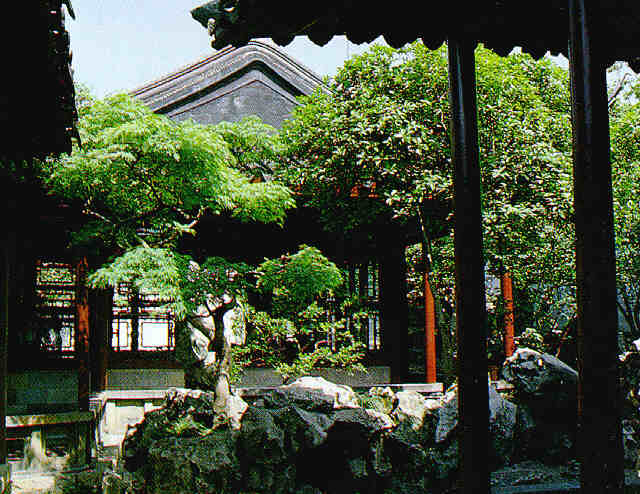
|
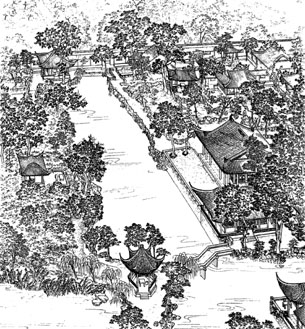
|
|
A corner of the Garden of the Artless Official
|
| SOURCE:
Photograph courtesy of Jerome Silbergeld. |
|
Bird's eye view of Garden of the Artless Official
| SOURCE:
Liu Dunzhen. Suzhou gudian yuanlin (Nanjing: Zhongguo
jianzhu gongye chubanshe, 1979). |
|
|
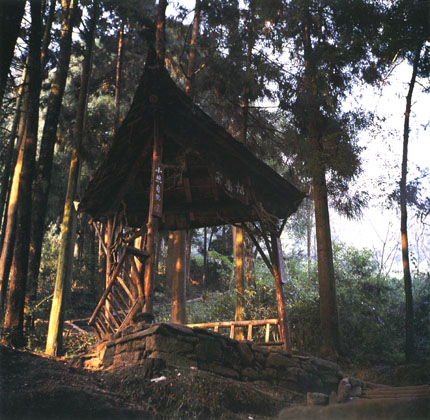 An
overall impression of tidiness and precision rarely strikes the visitor
to a Chinese garden. Unlike its Japanese counterpart, the Chinese garden
is enjoyed for its apparent disorder. Most gardens try to incorporate
aspects of rusticity and spontaneity inherent in nature. This is a
similar goal to that found in many Chinese paintings where subjects,
such as gnarled trees or rigid bamboo (see the painting at the top of
this page), are often chosen for their character. An
overall impression of tidiness and precision rarely strikes the visitor
to a Chinese garden. Unlike its Japanese counterpart, the Chinese garden
is enjoyed for its apparent disorder. Most gardens try to incorporate
aspects of rusticity and spontaneity inherent in nature. This is a
similar goal to that found in many Chinese paintings where subjects,
such as gnarled trees or rigid bamboo (see the painting at the top of
this page), are often chosen for their character.
|
|
Treebark
pavilion, Chongqing (Sichuan province)
| SOURCE:
Pan Guxi, ed., Zhongguo meishu quanji, Jianzhu yishu
3: Yuanlin jianzhu (Beijing: Zhongguo jianzhu gongye
chubanshe, 1988), p. 181. Rustic pavilion, Green
Wall Mountain Pavilion, Guan county, Sichuan province. |
|
|
What positive value do you think disorder might play
in a Chinese garden?
|
|
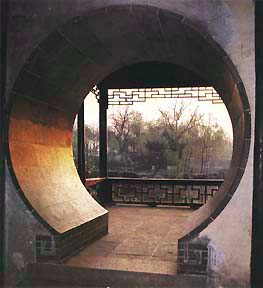 The
personality of the garden's designer determined to a large extent the
types of buildings, plants, and other features that were selected. The
exterior environment might also influence how rustic or elegant a garden
was in its architecture and decorative details. The
personality of the garden's designer determined to a large extent the
types of buildings, plants, and other features that were selected. The
exterior environment might also influence how rustic or elegant a garden
was in its architecture and decorative details.
Compare the Treebark pavilion (above) with the view
through this gate in a city garden.
How do they each take advantage of the natural
surroundings?
| HINT:
Consider the ways views are framed by these different
architectural structures. |
|
|
Moon gate, Garden
of the Artless Official, Suzhou
| SOURCE:
Pan Guxi, ed., Zhongguo meishu quanji, Jianzhu yishu bian 3:
Yuanlin jianzhu (Beijing: Zhongguo jianzhu gongye chubanshe,
1988), pl. 88, p. 90. |
|
|
|
|
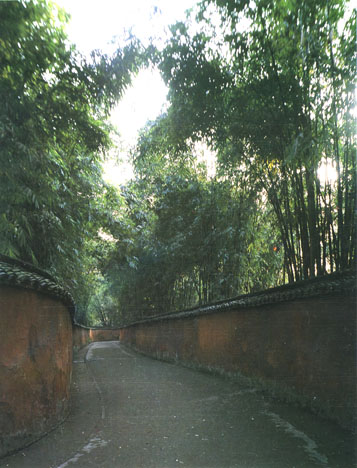 Another
preference in garden design is to use shapes that metaphorically refer
to elements in nature; some of the subtlest examples of this practice
are also the most highly appreciated. The wall opening, above, is one
example of an allusion to nature. Another
preference in garden design is to use shapes that metaphorically refer
to elements in nature; some of the subtlest examples of this practice
are also the most highly appreciated. The wall opening, above, is one
example of an allusion to nature.
What might be some reasons for undulating walkways or
walls in a garden like the one on the right?
| ANSWER:
Like pavilions, crooked pathways are intended to make a visitor
slow down to better appreciate views. In terms of fengshui,
undulating paths prevent bad spirits, who can only travel in
straight lines, from progressing forward. |
|
|
Wall and bamboo at
the Shrine of Count Wu (Zhuge Liang), Chengdu (Sichuan
province)
|
| SOURCE: Pan Guxi, ed., Zhongguo meishu quanji, Jianzhu yishu bian 3:
Yuanlin jianzhu (Beijing: Zhongguo jianzhu gongye chubanshe,
1988), p. 176. |
|
|
|
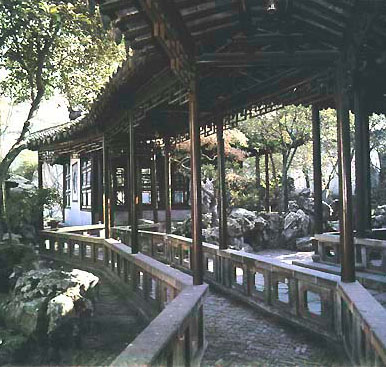
|
|
Covered walkway at the Garden of the
Master of Nets, Suzhou
(Jiangsu province)
| SOURCE:
Pan Guxi, ed., Zhongguo meishu quanji, Jianzhu yishu
bian 3: Yuanlin jianzhu (Beijing: Zhongguo jianzhu
gongye chubanshe, 1988), p. 107. |
|
|
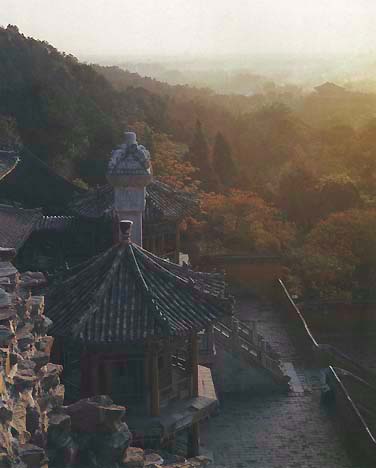
Special thought was given to planning the Chinese garden
for year-round enjoyment. It was thought that the garden should have a
distinct look in each different season of the year.
How do you think the planners incorporated this
preference into their final design of this garden?
|
|
Rejoicing in the
West Tower, Chongqing (Sichuan province)
| SOURCE:
Pan Guxi, ed., Zhongguo meishu quanji, Jianzhu yishu
3: Yuanlin jianzhu (Beijing: Zhongguo jianzhu gongye
chubanshe, 1988), pl. 88, p. 90. Autumn scenery viewed
from Rejoicing in the West Tower, Chongqing (Sichuan province). |
Move on to Garden
of the Master of Nets
|

